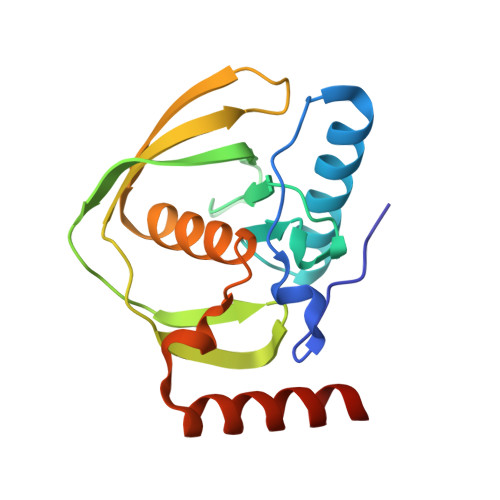Antibiotic activity and characterization of BB-3497, a novel peptide deformylase inhibitor.
Clements, J.M., Beckett, R.P., Brown, A., Catlin, G., Lobell, M., Palan, S., Thomas, W., Whittaker, M., Wood, S., Salama, S., Baker, P.J., Rodgers, H.F., Barynin, V., Rice, D.W., Hunter, M.G.(2001) Antimicrob Agents Chemother 45: 563-570
- PubMed: 11158755
- DOI: https://doi.org/10.1128/AAC.45.2.563-570.2001
- Primary Citation of Related Structures:
1G27, 1G2A - PubMed Abstract:
Peptide deformylase (PDF) is an essential bacterial metalloenzyme which deformylates the N-formylmethionine of newly synthesized polypeptides and as such represents a novel target for antibacterial chemotherapy. To identify novel PDF inhibitors, we screened a metalloenzyme inhibitor library and identified an N-formyl-hydroxylamine derivative, BB-3497, and a related natural hydroxamic acid antibiotic, actinonin, as potent and selective inhibitors of PDF. To elucidate the interactions that contribute to the binding affinity of these inhibitors, we determined the crystal structures of BB-3497 and actinonin bound to Escherichia coli PDF at resolutions of 2.1 and 1.75 A, respectively. In both complexes, the active-site metal atom was pentacoordinated by the side chains of Cys 90, His 132, and His 136 and the two oxygen atoms of N-formyl-hydroxylamine or hydroxamate. BB-3497 had activity against gram-positive bacteria, including methicillin-resistant Staphylococcus aureus and vancomycin-resistant Enterococcus faecalis, and activity against some gram-negative bacteria. Time-kill analysis showed that the mode of action of BB-3497 was primarily bacteriostatic. The mechanism of resistance was via mutations within the formyltransferase gene, as previously described for actinonin. While actinonin and its derivatives have not been used clinically because of their poor pharmacokinetic properties, BB-3497 was shown to be orally bioavailable. A single oral dose of BB-3497 given 1 h after intraperitoneal injection of S. aureus Smith or methicillin-resistant S. aureus protected mice from infection with median effective doses of 8 and 14 mg/kg of body weight, respectively. These data validate PDF as a novel target for the design of a new generation of antibacterial agents.
- British Biotech Pharmaceuticals Ltd., Oxford OX4 6LY, United Kingdom. clements@britbio.co.uk
Organizational Affiliation:


















